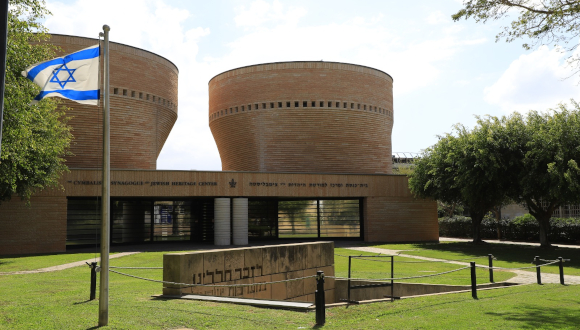TAU’s Cymbalista Synagogue and Jewish Heritage Center designated a protected historic site

Status signifies the building’s unique qualities, both architecturally and socially
Support Tel Aviv UniversityThe Cymbalista Synagogue and Jewish Heritage Center at Tel Aviv University (TAU) has been designated a protected “Heritage Site” by the Council for the Conservation of Heritage Sites in Israel, one of Israel’s top conservation authorities.
Completed in 1998, the building is currently the “youngest” in the country to hold this status. The designation signifies the building’s unique qualities, both in its architectural and social aspects and ensures the physical preservation of the Cymbalista Synagogue as a building of historic significance.
The Cymbalista Synagogue and Jewish Heritage Center is located at the heart of the campus. An impressive building with its broad square base rising into two spiraling towers emblematic of a Torah scroll, the Cymbalista Synagogue and Jewish Heritage Center is a landmark work of architecture on campus and in Israel. It functions as a synagogue. The Center also serves as an academic and cultural meeting ground and includes a study room and library. Its facilities include an auditorium and museum. Members of the public can use the synagogue as a venue for weddings and bar mitzvahs.
Swiss real estate developer, philanthropist, and TAU Honorary Doctor and Governor Norbert Cymbalista and his wife Paulette commissioned the building. It was devised to house a synagogue and bridge the gaps between religious and secular segments of Israeli society — and between the different denominations of Judaism: Orthodox, Conservative and Reform — in an academic environment.
“I am thrilled for the new designation, which reaffirms my decision to create a space in the spirit of respect for tradition, but also in the realization that dialogue and acceptance of different viewpoints are essential for Israel’s development as a democratic society,” Cymbalista said. “I hope that the Cymbalista Synagogue and Jewish Heritage Center will continue to serve as a focal point of activity and that I will see its impact on further strengthening ties in my lifetime.”
“Cymbalista Synagogue and Jewish Heritage Center is situated at the heart of the campus and is a symbol and an example of unity and community,” added TAU President Professor Ariel Porat. “The Center reflects the liberal and pluralistic nature of TAU. I would like to express my gratitude to Norbert Cymbalista, a loyal friend of the university and the state of Israel, for his important contribution to promoting these important values in the campus.”
“The new designation is an immense honor for the Center, and an exciting recognition of its architectural and cultural importance,” said Dr. Yair Lipshitz, Head of the Cymbalista Jewish Heritage Center. “In many ways, the building is a profound response to the question of what it means to foster Jewish culture at the heart of TAU. Its multipurpose functionality offers a complex, dynamic, and unique interplay between the various facets of being Jewish in Israel today. The preservation of such a building as a heritage landmark ensures the endurance of the vision that is set in its stones — a vision for a rich, pluralistic, multi-voiced Israeli culture.”
Cymbalista explains that the building’s initial construction plans were solely for a synagogue. However, the assassination of former Israeli Prime Minister Yitzhak Rabin by an Israeli Jew reinforced Cymbalista’s fear that the most dangerous challenge facing Israel was the rift between the religious and secular segments of the population, which he believed could tear the country apart. Therefore, he identified the opportunity to do more and create a comprehensive center, where those two realities of Israel life could meet and engage in dialogue within an academic environment. As such, the building’s design was expanded to nearly double the original blueprint to include an auditorium, beit midrash (study facility for Jewish scripture), and Judaica museum, the first of its kind in the Tel Aviv area.
Renowned Swiss architect Mario Botta designed the building. It contains materials and furnishings from around the world, including the Torah ark made of Pakistani onyx stone, golden-hued stone interior walls from Tuscany, black granite flooring from Zimbabwe, brick red exterior stone from the Italian Dolomites, and a light wood ceiling from Switzerland.